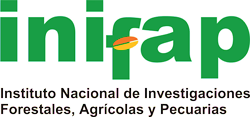PRODUCTION OF Prosopis laevigata (Humb. et Bonpl. ex Willd.) M.C. Johnst. WITH DIFFERENT SUBSTRATE MIXTURES
DOI:
https://doi.org/10.29298/rmcf.v4i20.369Keywords:
Composted bark, base mix, seedling, Prosopis laevigata (Humb. et Bonpl. ex Willd) M. C. Johnst., substrates, nurseryAbstract
Five substrate mixtures were evaluated with the purpose of determining their effect on the quality of Prosopis laevigata seedlings growing in a nursery; substrates were composed by base mix (50 % peat moss + 24 % agrolite + 21 % vermiculite) and composted pine bark. The mixtures were: 1) 50 % composted pine bark + 50 % base mix, 2) 60 % composted pine bark + 40 % base mix, 3) 70 % composted pine bark + 30 % base mix, 4) 80 % composted pine bark + 20 % base mix, and 5) 100 % base mix. During substrate preparation 7 kg m-3 of Multicote® granular fertilizer were added. Polystyrene trays of 77 cavities with 170 mL per cavity were used. Experimental design was completely randomized and each treatment was constituted by four replicates. Response variables were: height, root collar diameter, dry total biomass and Dickson quality index. When the seedlings attained the age of five months, significant statistical differences were found due to substrate mixtures, with the mix composed by 50 % composted pine bark + 50 % base mix showing superiority in most of variables. After this, the other mixtures showed similar results, except for the substrate composed by 80 % composted pine bark + 20 % base mix, which had the lowest values for all the variables. The results indicate that composted pine bark is a possible alternative substrate that may contribute to reduce production costs compared to the base mix, which has a high cost.
Downloads
Downloads
Published
How to Cite
Issue
Section
License
The authors who publish in Revista Mexicana de Ciencias Forestales accept the following conditions:
In accordance with copyright laws, Revista Mexicana de Ciencias Forestales recognizes and respects the authors’ moral right and ownership of property rights which will be transferred to the journal for dissemination in open access.
All the texts published by Revista Mexicana de Ciencias Forestales –with no exception– are distributed under a Creative Commons License Attribution-NonCommercial 4.0 International (CC BY-NC 4.0), which allows third parties to use the publication as long as the work’s authorship and its first publication in this journal are mentioned
The author(s) can enter into independent and additional contractual agreements for the nonexclusive distribution of the version of the article published in Revista Mexicana de Ciencias Forestales (for example, include it into an institutional repository or publish it in a book) as long as it is clearly and explicitly indicated that the work was published for the first time in Revista Mexicana de Ciencias Forestales.
For all the above, the authors shall send the form of Letter-transfer of Property Rights for the first publication duly filled in and signed by the author(s). This form must be sent as a PDF file to: ciencia.forestal2@inifap.gob.mx
This work is licensed under a Creative Commons Attribution-Noncommercial 4.0 International license.






